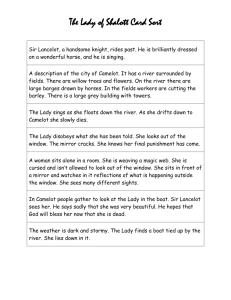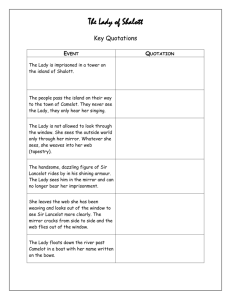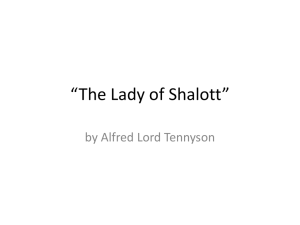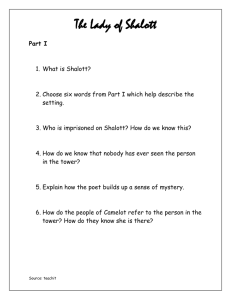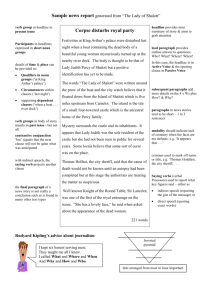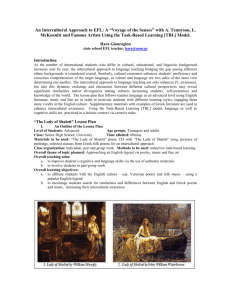The Lady of Shalott: Tennyson's Poem Analysis
advertisement
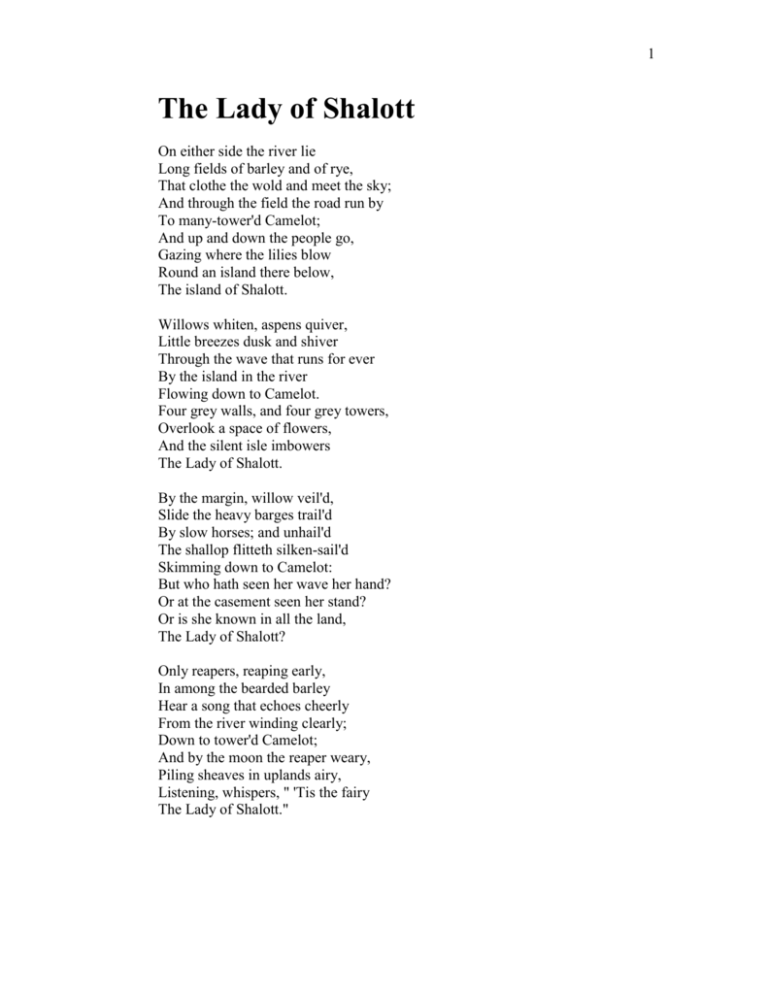
1 The Lady of Shalott On either side the river lie Long fields of barley and of rye, That clothe the wold and meet the sky; And through the field the road run by To many-tower'd Camelot; And up and down the people go, Gazing where the lilies blow Round an island there below, The island of Shalott. Willows whiten, aspens quiver, Little breezes dusk and shiver Through the wave that runs for ever By the island in the river Flowing down to Camelot. Four grey walls, and four grey towers, Overlook a space of flowers, And the silent isle imbowers The Lady of Shalott. By the margin, willow veil'd, Slide the heavy barges trail'd By slow horses; and unhail'd The shallop flitteth silken-sail'd Skimming down to Camelot: But who hath seen her wave her hand? Or at the casement seen her stand? Or is she known in all the land, The Lady of Shalott? Only reapers, reaping early, In among the bearded barley Hear a song that echoes cheerly From the river winding clearly; Down to tower'd Camelot; And by the moon the reaper weary, Piling sheaves in uplands airy, Listening, whispers, " 'Tis the fairy The Lady of Shalott." 2 There she weaves by night and day A magic web with colours gay. She has heard a whisper say, A curse is on her if she stay To look down to Camelot. She knows not what the curse may be, And so she weaveth steadily, And little other care hath she, The Lady of Shalott. And moving through a mirror clear That hangs before her all the year, Shadows of the world appear. There she sees the highway near Winding down to Camelot; There the river eddy whirls, And there the surly village churls, And the red cloaks of market girls Pass onward from Shalott. Sometimes a troop of damsels glad, An abbot on an ambling pad, Sometimes a curly shepherd lad, Or long-hair'd page in crimson clad Goes by to tower'd Camelot; And sometimes through the mirror blue The knights come riding two and two. She hath no loyal Knight and true, The Lady of Shalott. But in her web she still delights To weave the mirror's magic sights, For often through the silent nights A funeral, with plumes and lights And music, went to Camelot; Or when the Moon was overhead, Came two young lovers lately wed. "I am half sick of shadows," said The Lady of Shalott. 3 A bow-shot from her bower-eaves, He rode between the barley sheaves, The sun came dazzling thro' the leaves, And flamed upon the brazen greaves Of bold Sir Lancelot. A red-cross knight for ever kneel'd To a lady in his shield, That sparkled on the yellow field, Beside remote Shalott. The gemmy bridle glitter'd free, Like to some branch of stars we see Hung in the golden Galaxy. The bridle bells rang merrily As he rode down to Camelot: And from his blazon'd baldric slung A mighty silver bugle hung, And as he rode his armor rung Beside remote Shalott. All in the blue unclouded weather Thick-jewell'd shone the saddle-leather, The helmet and the helmet-feather Burn'd like one burning flame together, As he rode down to Camelot. As often thro' the purple night, Below the starry clusters bright, Some bearded meteor, burning bright, Moves over still Shalott. His broad clear brow in sunlight glow'd; On burnish'd hooves his war-horse trode; From underneath his helmet flow'd His coal-black curls as on he rode, As he rode down to Camelot. From the bank and from the river He flashed into the crystal mirror, "Tirra lirra," by the river Sang Sir Lancelot. 4 She left the web, she left the loom, She made three paces through the room, She saw the water-lily bloom, She saw the helmet and the plume, She look'd down to Camelot. Out flew the web and floated wide; The mirror crack'd from side to side; "The curse is come upon me," cried The Lady of Shalott. In the stormy east-wind straining, The pale yellow woods were waning, The broad stream in his banks complaining. Heavily the low sky raining Over tower'd Camelot; Down she came and found a boat Beneath a willow left afloat, And around about the prow she wrote The Lady of Shalott. And down the river's dim expanse Like some bold seer in a trance, Seeing all his own mischance -With a glassy countenance Did she look to Camelot. And at the closing of the day She loosed the chain, and down she lay; The broad stream bore her far away, The Lady of Shalott. Lying, robed in snowy white That loosely flew to left and right -The leaves upon her falling light -Thro' the noises of the night, She floated down to Camelot: And as the boat-head wound along The willowy hills and fields among, They heard her singing her last song, The Lady of Shalott. 5 Heard a carol, mournful, holy, Chanted loudly, chanted lowly, Till her blood was frozen slowly, And her eyes were darkened wholly, Turn'd to tower'd Camelot. For ere she reach'd upon the tide The first house by the water-side, Singing in her song she died, The Lady of Shalott. Under tower and balcony, By garden-wall and gallery, A gleaming shape she floated by, Dead-pale between the houses high, Silent into Camelot. Out upon the wharfs they came, Knight and Burgher, Lord and Dame, And around the prow they read her name, The Lady of Shalott. Who is this? And what is here? And in the lighted palace near Died the sound of royal cheer; And they crossed themselves for fear, All the Knights at Camelot; But Lancelot mused a little space He said, "She has a lovely face; God in his mercy lend her grace, The Lady of Shalott." http://charon.sfsu.edu/tennyson/TENNLADY.HTML 6 The Lady of Shalott Jump to: navigation, search John William Waterhouse's The Lady of Shalott, 1888 (Tate Gallery, London) For the Waterhouse painting, see The Lady of Shalott (painting). "Shalott" redirects here. For other uses, see Shalott (disambiguation). "The Lady of Shalott" is a Victorian poem or ballad by the English poet Alfred, Lord Tennyson (1809–1892). Like his other early poems – "Sir Lancelot and Queen Guinevere" and "Galahad" – the poem recasts Arthurian subject matter loosely based on medieval sources. Overview Waterhouse's The Lady of Shalott Looking at Lancelot 7 Tennyson wrote two versions of the poem, one published in 1833, of twenty stanzas, the other in 1842 of nineteen stanzas. It was loosely based on the Arthurian legend of Elaine of Astolat, as recounted in a thirteenth-century Italian novella entitled Donna di Scalotta (No, lxxxi in the collection "Cento Novelle Antiche" actually), with the earlier version being closer to the source material than the later.[1] Tennyson focused on the Lady's "isolation in the tower and her decision to participate in the living world, two subjects not even mentioned in Donna di Scalotta."[2] Synopsis The first four stanzas describe a pastoral setting. The Lady of Shalott lives in an island castle in a river which flows to Camelot, but little is known about her by the local farmers. And by the moon the reaper weary, Piling sheaves in uplands airy, Listening, whispers, " 'Tis the fairy The Lady of Shalott." Stanzas five through eight describe the lady's life. She has been cursed, and so must constantly weave a magic web without looking directly out at the world. Instead, she looks into a mirror which reflects the busy road and the people of Camelot which pass by her island. She knows not what the curse may be, And so she weaveth steadily, And little other care hath she, The Lady of Shalott. Stanzas nine through twelve describe "bold Sir Lancelot" as he rides past, and is seen by the lady. All in the blue unclouded weather Thick-jewell'd shone the saddle-leather, The helmet and the helmet-feather Burn'd like one burning flame together, As he rode down to Camelot. The remaining seven stanzas describe the effect of seeing Lancelot on the lady; she stops weaving and looks out her window toward Camelot, bringing about the curse. Out flew the web and floated wideThe mirror crack'd from side to side; "The curse is come upon me," cried The Lady of Shalott. 8 She leaves her tower, finds a boat upon which she writes her name, and floats down the river to Camelot. She dies before arriving at the palace, and among the knights and ladies who see her is Lancelot. "Who is this? And what is here?" And in the lighted palace near Died the sound of royal cheer; And they crossed themselves for fear, All the Knights at Camelot; But Lancelot mused a little space He said, "She has a lovely face; God in his mercy lend her grace, The Lady of Shalott." Themes Some consider "The Lady of Shalott" to be representative of the dilemma that faces artists, writers, and musicians: to create work about and celebrating the world, or to enjoy the world by simply living in it. Others see the poem as concerned with issues of women's sexuality and their place in the Victorian world. The fact that the poem works through such complex and polyvalent symbolism indicates an important difference between Tennyson's work and his Arthurian source material. While Tennyson's sources tended to work through allegory, Tennyson himself did not. http://en.wikipedia.org/wiki/The_Lady_of_Shalott 9 If you are approaching Tennyson's poem, "The Lady of Shalott", the following will help you get started. It is intended especially for students (high-school age and older) who have read the poem in class. The Story The Lady of Shalott is a magical being who lives alone on an island upstream from King Arthur's Camelot. Her business is to look at the world outside her castle window in a mirror, and to weave what she sees into a tapestry. She is forbidden by magic to look at the outside world directly. The farmers who live near her island hear her singing and know who she is, but never see her. The Lady sees ordinary people, loving couples, and knights in pairs reflected in her mirror. One day, she sees the reflection of Sir Lancelot riding alone. Although she knows that it is forbidden, she looks out the window at him. The mirror shatters, the tapestry flies off on the wind, and the Lady feels the power of her curse. An autumn storm suddenly arises. The lady leaves her castle, finds a boat, writes her name on it, gets into the boat, sets it adrift, and sings her death song as she drifts down the river to Camelot. The locals find the boat and the body, realize who she is, and are saddened. Lancelot prays that God will have mercy on her soul. This is one of Tennyson's most popular poems. The Pre-Raphaelites liked to illustrate it. Waterhouse made three separate paintings of "The Lady of Shalott". Agatha Christie wrote a Miss Marple mystery entitled "The Mirror Crack'd From Side to Side", which was made into a movie starring Angela Lansbury. Tirra Lirra by the River, by Australian novelist Jessica Anderson, is the story of a modern woman's decision to break out of confinement. 10 The Poem The Lady Of Shalott 1842 Version 1832 Version I On either side the river lie Long fields of barley and of rye, That clothe the wold and meet the sky; And through the field the road runs by To many-tower'd Camelot; And up and down the people go, Gazing where the lilies blow Round an island there below, The island of Shalott. Willows whiten, aspens quiver, Little breezes dusk and shiver Through the wave that runs for ever By the island in the river Flowing down to Camelot. Four grey walls, and four grey towers, Overlook a space of flowers, And the silent isle embowers The Lady of Shalott. ... ... ... ... ... The yellowleavèd waterlily, The greensheathèd daffodilly, Trembled in the water chilly, Round about Shalott Tennyson changed a copy of the 1832 version to "The yellow globe o' the waterlily". Probably the water lilies had green leaves and yellow flowers. ... ... The sunbeam-showers break and quiver In the stream that runneth ever ... ... ... ... ... By the margin, willow-veil'd, Slide the heavy barges trail'd By slow horses; and unhailed The shallop flitteth, silken-sail'd Skimming down to Camelot Yet who hath seen her wave her hand? Or at the casement seen her stand? Or is she know in all the land, The Lady of Shalott? Underneath the bearded barley, The reaper, reaping late and early Hears her ever chanting cheerly, Like an angel, singing clearly, O'er the stream of Camelot. Piling the sheaves in furrows airy, Beneath the moon, the reaper weary Listening, whispers, "'Tis the fairy Lady of Shalott." Only reapers, reaping early, In among the beared barley Hear a song that echoes cheerly From the river winding clearly, Down to towered Camelot: And by the moon the reaper weary, Piling sheaves in uplands airy, Listening, whispers, " 'Tis the fairy Lady of Shalott." The little isle is all inrailed With a rose-fence, and overtrailed With roses: by the marge unhailed The shallop flitteth silen-sailed Skimming down to Camelot: A pearlgarland winds her head; She leaneth on a velvet bed, Fully royally apparelèd, The Lady of Shalott. 11 II There she weaves by night and day A magic web with colours gay. She has heard a whisper say, A curse is on her if she stay To look down to Camelot. She knows not what the curse may be, And so she weaveth steadily, And little other care hath she, The Lady of Shalott. And moving through a mirror clear That hangs before her all the year, Shadows of the world appear. There she sees the highway near Winding down to Camelot; There the river eddy whirls, And there the surly village churls, And the red cloaks of market girls Pass onward from Shalott. Sometimes a troop of damsels glad, An abbot on an ambling pad, Sometimes a curly shepherd lad, Or long-hair'd page in crimson clad, Goes by to tower'd Camelot; And sometimes through the mirror blue The knights come riding two and two: She hath no loyal knight and true, The Lady of Shalott. But in her web she still delights To weave the mirror's magic sights, For often through the silent nights A funeral, with plumes and lights And music, went to Camelot: Or when the Moon was overhead, Came two young lovers lately wed; "I am half sick of shadows," said The Lady of Shalott. No time hath she to sport and play: A charmèd web she weaves alway. A curse is on her, if she stay Her weaving, either night or day, To look down to Camelot. She knows not what the curse may be, Therefore she weaveth steadily, Therefore no other care hath she, The Lady of Shalott. 12 III A bow-shot from her bower-eaves, He rode between the barley sheaves, The sun came dazzling thro' the leaves, And flamed upon the brazen greaves Of bold Sir Lancelot. A red-cross knight for ever kneeled To a lady in his shield, That sparkled on the yellow field, Beside remote Shalott. The gemmy bridle glitter'd free, Like to some branch of stars we see Hung in the golden Galaxy. The bridle bells rang merrily As he rode down to Camelot: And from his blazon'd baldric slung A mighty silver bugle hung, And as he rode his armor rung Beside remote Shalott. All in the blue unclouded weather Thick-jewell'd shone the saddle-leather, The helmet and the helmet-feather Burn'd like one burning flame together, As he rode down to Camelot. As often thro' the purple night, Below the starry clusters bright, Some bearded meteor, trailing light, Moves over still Shalott. His broad clear brow in sunlight glow'd; On burnish'd hooves his war-horse trode; From underneath his helmet flow'd His coal-black curls as on he rode, As he rode down to Camelot. From the bank and from the river He flashed into the crystal mirror, "Tirra lirra," by the river Sang Sir Lancelot. ... ... ... ... As he rode down from Camelot: ... ... ... ... ... ... ... ... As he rode down from Camelot: ... ... ... Moves over green Shalott. ... ... ... ... As he rode down from Camelot: ... ... "Tirra lirra, tirra lirra" ... 13 She left the web, she left the loom, She made three paces through the room, She saw the water-lily bloom, She saw the helmet and the plume, She look'd down to Camelot. Out flew the web and floated wide; The mirror crack'd from side to side; "The curse is come upon me," cried The Lady of Shalott. ... ... She saw the waterflower bloom ... ... ... ... ... ... IV In the stormy east-wind straining, The pale yellow woods were waning, The broad stream in his banks complaining. Heavily the low sky raining Over tower'd Camelot; Down she came and found a boat Beneath a willow left afloat, And around about the prow she wrote The Lady of Shalott. ... ... ... ... ... Outside the isle a shallow boat Beneath a willow lay afloat Below the carven stern she wrote ... A cloudwhite crown of pearl she dight All raimented in snowy white That loosely flew, (her zone in sight, Clasped with one blinding diamond bright,) Her wide eyes fixed on Camelot Thought the squally eastwind keenly Blew, with folded arms serenely By the water stood the queenly Lady of Shalott. And down the river's dim expanse Like some bold seer in a trance, Seeing all his own mischance -With a glassy countenance Did she look to Camelot. And at the closing of the day She loosed the chain, and down she lay; The broad stream bore her far away, The Lady of Shalott. And down the river's dim expanse With a steady, stony glance Beholding all her own mischance Mute, with a glassy countenance She looked down to Camelot It was the closing of the day, ... ... ... 14 Lying, robed in snowy white That loosely flew to left and right -The leaves upon her falling light -Thro' the noises of the night, She floated down to Camelot: And as the boat-head wound along The willowy hills and fields among, They heard her singing her last song, The Lady of Shalott. As when to sailors while they roam, By creeks and outfalls far from home, Rising and dropping with the foam, From dying swans wild warblings come, Blown shoreward; so to Camelot Still as the boat--head wound along The willowy hills and fields among, They heard her chanting her deathsong The Lady of Shalott. Heard a carol, mournful, holy, Chanted loudly, chanted lowly, Till her blood was frozen slowly, And her eyes were darkened wholly, Turn'd to tower'd Camelot. For ere she reach'd upon the tide The first house by the water-side, Singing in her song she died, The Lady of Shalott. A longdrawn carol, mournful, holy, She chanted loudly, chanted lowly, Till her eyes were darkened wholly, And her smooth face sharpened slowly. ... ... ... ... ... Under tower and balcony, By garden-wall and gallery, A gleaming shape she floated by, Dead-pale between the houses high, Silent into Camelot. Out upon the wharfs they came, Knight and burgher, lord and dame, And around the prow they read her name, The Lady of Shalott. ... ... A pale, pale corpse she floated by, Deadcold between the houses high, Dead into towered Camelot Knight and burgher, lord and dame, To the plankèd wharfage came: Below the stern they read her name, ... Who is this? And what is here? And in the lighted palace near Died the sound of royal cheer; And they crossed themselves for fear, All the Knights at Camelot; But Lancelot mused a little space He said, "She has a lovely face; God in his mercy lend her grace, The Lady of Shalott." They crossed themselves, their stars they blest, Knight, minstrel, abbot, squire and guest, There lay a parchment on her breast, That puzzled more than all the rest, The wellfed wits at Camelot. "The web was woven curiously, The charm is broken utterly, Draw near and fear not -- this is I, The Lady of Shalott." 15 Notes The story of the Lady of Shalott is a version of "Elaine the fair maid of Astolat", from Thomas Malory's Morte d'Arthur. Elaine's naive love for Lancelot was unrequited. She died of a broken heart (i.e., committed suicide -- Malory's book contains her justification of suicide). Her dead body (with suicide note between her hands) was floated down the Thames to Camelot. Eventually Tennyson wrote a long poem about "Lancelot and Elaine". It contains the line which I have found helpful, "He makes no friend who never made a foe." However, Tennyson claimed he did not know the English version of the story in 1832, when he wrote the first draft of the poem. He took it from an early renaissance Italian story "Quì conta come la Damigella di Scalot morì per amore di Lancialotto de Lac." The body ends up on the Camelot beach, with a letter, and is examined by a crowd. I met the story first in some italian novelle: but the web, mirror, island, etc., were my own. Indeed, I doubt whether I should ever have put it in that shape if I had been then aware of the Maid of Astolat in "Morte Arthur". Tennyson found the basic story in the Italian source, including the death-letter (which he eliminated from the 1842 version). But he made up the curse, the mirror, the song, and the weaving. Tennyson also explained, The Lady of Shalott is evidently the Elaine of the Morte d'Arthur, but I do not think that I had ever heard of the latter when I wrote the former. Shalott was a softer sound than "Scalott". Like many other famous poems, this one deals (on one level) about writing poetry. Tennyson's son Hallam quoted his father as saying it's about: the new-born love for something, for some one in the wide world for which she had been so long excluded, takes her out of the region of shadows into that of realities. 16 Hallam also said: The key to this tale of magic symbolism is of deep human significance and is to be found in the lines Or when the Moon was overhead, Came two young lovers lately wed; "I am half sick of shadows," said The Lady of Shalott. Tennyson likes to write poems about creatures lost in half-life, and/or people taking decisive, heroic action that leads to their doom. The Kraken is a science-fiction sort of creature that will become conscious only moments before its spectacular death. The Lotus-Eaters are in a drug-haze. Tithonous is lost in extreme old age. Miriana and Oenone are poems about lonely women. "The Charge of the Light Brigade" glorifies the men who died as a result of a terrible military error. "Ulysses" glorifies a heroic quest for even-Ulysses-doesn't-know-what. If you know the story from Dante, you remember that Ulysses and all his crew drowned. "The Idealist" spoofs a philosopher who thinks the world is his hallucination. Here are some more interesting things to notice about "The Lady of Shalott": The key line, "I am half-sick of shadows", says the Lady's mind, and probably the poet's mind, is divided about the right choice. Each of the four stanzas ends with somebody saying something. Otherwise nobody says anything. Most of the knights are riding as buddy pairs. Lancelot is riding alone. He has no partner except his reflection in the river. The reflection in the river is in turn reflected in the mirror. The poem has been very popular among illustrators, perhaps for its suggestiveness. Note Lance's lance in the one picture. "Tirra lirra" comes from "The Winter's Tale" by Shakespeare. The redcross knight is the hero of the beginning of Spenser's "Faery Queene". 17 Not everybody thinks that "Tirra lirra by the river" is a great line. But notice that "river" rhymes with "river", either because there is no other obvious rhyme, or because there is a reflection in the river. Mirror doesn't really rhyme with river, but it sort of rhymes with tirra lirra. Uh, yeah, I agree that "plankèd wharfage" sounds silly today. Lancelot prays that God will have mercy on the Lady. At the time, Lancelot is the queen's illicit lover, and thus false to the king he loves. Eventually a contrite Lancelot became a man of God. Lancelot is the one who will receive mercy. Lancelot's prayer that God will have mercy on the lady probably comes from the old version in which she is an actual suicide. You've probably already thought about how the Lady's castle and mirror compares with Plato's Cave. In Plato, the reflections are the phenomenal world; in Tennyson, the phenomenal world casts the reflections. Leaving both cave and castle supposedly results in disaster. How can you read something that was written "below the stern" of a boat? It would be below the water line. One early reviewer pointed this out. John Stuart Mill understandably disliked the last stanza of the 1832 version in the London Reveiw, July 1835. If you are allowed to do "Compare and Contrast" papers (i.e., if you are only beginning your study of literature), get Tennyson's "Life of the Life", a companion-piece to "The Lady of Shalott". Funeral barges and dead bodies going down rivers are some sort of archetype. Ophelia, Buoconte di Montefeltro (Dante Purg. V), and Boromir ("Lord of the Rings") are three other favorites from classic literature. Because the Lady of Shalott is an allegorical figure, she has no given name. One of my correspondents (Catherine Mulligan) pointed out that at the start, there's no color, only shadows. Later, the lady chooses "the bright colors of reality". When she dies, we hear only of white, one of the hueless "colors" of death. What's It All About, Alfie? Obviously the Lady looking at the world in a mirror and depicting it in a work of art is some kind of allegory for the life of the artistwriter. I think that "The Lady of Shalott" is partly about how being an artist (writer, poet, scholar, etc.) can make you feel isolated from ordinary life. You can develop this idea yourself, based on your own experience and observations. It's the Lady's romantic yearnings that finally make her look out the window. In the 1830's, a poet was supposed to be a spokesman for a "Victorian" ideal in which sexuality is suppressed. Tennyson wrote "The Lady of Shalott" in his early 20's, just after being forced to leave Cambridge for financial reasons. He would not marry until 1849. The 18 young Tennyson must have wondered whether he could hold to the supposed contemporary standard for a single man rather than seeking out sexual relationships. He must have been afraid that choosing the latter would ruin his morals and his writing. You can look at Tennyson's own life and letters and decide for yourself to what extent "The Lady of Shalott" reflects the hopes and fears of a young man who grew up bookish, super-smart, isolated, and probably repressed. You can also look at what others have said about the old question of whether an artist or writer must be isolated from the ordinary world. Shakespeare and Chaucer were men of the world, who probably did not consider their writing to be their main professions. Lord Byron and Robert Burns embraced life and sexuality wholeheartedly. By contrast, Keats dropped out of medical school to become a full-time poet, Coleridge was a passive man who became dependent on the good will of others to be able to continue his work, and Emily Dickinson was a recluse. Bertoldt Brecht pretended to be a man of the working class, but he really had nothing to do with the people for whom he claimed to speak. You can supply many more examples. Today, "The Lady of Shalott" invites us to think about: o o What sacrifices must a person make to be a poet, artist, scientist, or scholar? We all have emotional needs. Can we really make these sacrifices? What happens when we fail? Each of us lives partly in a world of make-believe, much of it inherited from our families and our cultures. What happens when it is challenged and/or we choose to discard it? Archaic words: On an Ambling Pad: One resource says, "Taking a casual walk"; I think that since William Collins refers in his poem "In the Downhill of Life" to wanting "an ambling pad pony to pace o'er the lawn", and since a character in Henry Fielding's "Journey from This World to the Next" rides home on an ambling pad, it's probably "riding a horse." My dictionary says that "pad" can be British dialect for a walking path, or a saddle pad, or simply to walk in a leisurely way ("amble" is a synonym), or a horse that walks at an easy pace. Baldric: Belt worn over one shoulder and the opposite waist 19 Mischance: Bad luck (i.e., Tennyson's psychic foresees his own disaster) Greaves: Armor for the fronts of the shins Wold: Unforested plains, especially between forests. The Culture War: If you or your teacher are active in the perennial three-way struggle for control of the school curriculum and everything else, you can write an essay on "The Lady of Shalott" without being untruthful. Partisans of the Religious Right can point out the dangers of the occult, how the Lady was disobedient to some higher authority by seeking out sexual experience, how a good person stays aloof from the world, etc., etc. Partisans of the politically-correct Left can talk about how chivalry supposedly idealized women in order to confine and oppress them. Partisans of scientific naturalism can discuss Tennyson as the great poet of Darwin's era, giving brilliant expression in his later works all the religious doubts of the by-then postChristian world. Even in this early poem, the Lady gives up a world of unreality to look at and finally experience the world as it really is. Not everybody will agree with all these positions. http://www.pathguy.com/shalott.htm
